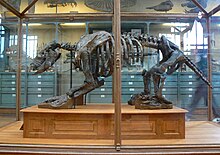| Scelidotheriidae | |
|---|---|

| |
| Scelidotherium leptocephalum in Paris | |
| Scientific classification | |
| Domain: | Eukaryota |
| Kingdom: | Animalia |
| Phylum: | Chordata |
| Class: | Mammalia |
| Order: | Pilosa |
| Superfamily: | Mylodontoidea |
| Family: | †Scelidotheriidae Ameghino 1889 |
| Genera | |
Scelidotheriidae is a family of extinct ground sloths within the order Pilosa, suborder Folivora and superfamily Mylodontoidea, related to the other extinct mylodontoid family, Mylodontidae, as well as to the living two-toed sloth family Choloepodidae. The only other extant family of the suborder Folivora is the distantly related Bradypodidae. Erected as the family Scelidotheriidae by Ameghino in 1889, the taxon was demoted to a subfamily of Mylodontidae by Gaudin in 1995.[1][2] However, recent collagen sequence data indicates the group is less closely related to Mylodon and Lestodon than Choloepus is, and thus it has been elevated back to full family status by Presslee et al. (2019).[3]
- ^ PaleoBiology Database: Scelidotheriinae, basic info
- ^ Gaudin, T. J. (1995-09-14). "The Ear Region of Edentates and the Phylogeny of the Tardigrada (Mammalia, Xenarthra)". Journal of Vertebrate Paleontology. 15 (3): 672–705. Bibcode:1995JVPal..15..672G. doi:10.1080/02724634.1995.10011255. JSTOR 4523658.
- ^ Presslee, S.; Slater, G. J.; Pujos, F.; Forasiepi, A. M.; Fischer, R.; Molloy, K.; et al. (2019). "Palaeoproteomics resolves sloth relationships" (PDF). Nature Ecology & Evolution. 3 (7): 1121–1130. Bibcode:2019NatEE...3.1121P. doi:10.1038/s41559-019-0909-z. PMID 31171860. S2CID 174813630. Archived (PDF) from the original on 12 September 2020. Retrieved 18 September 2020.